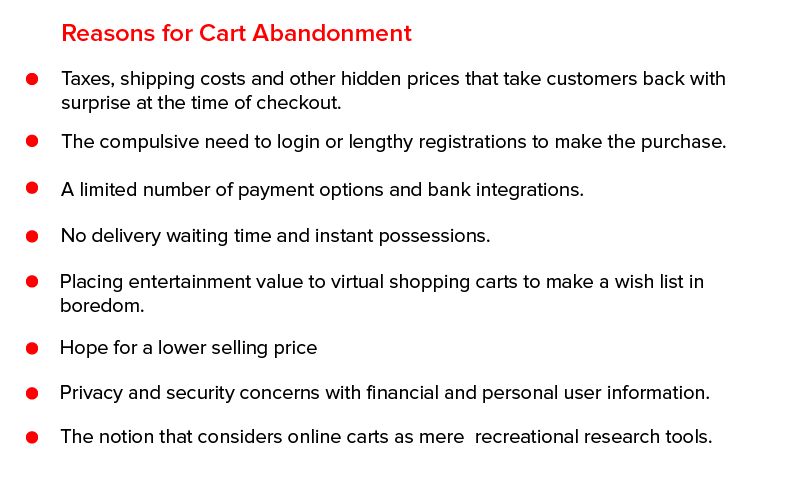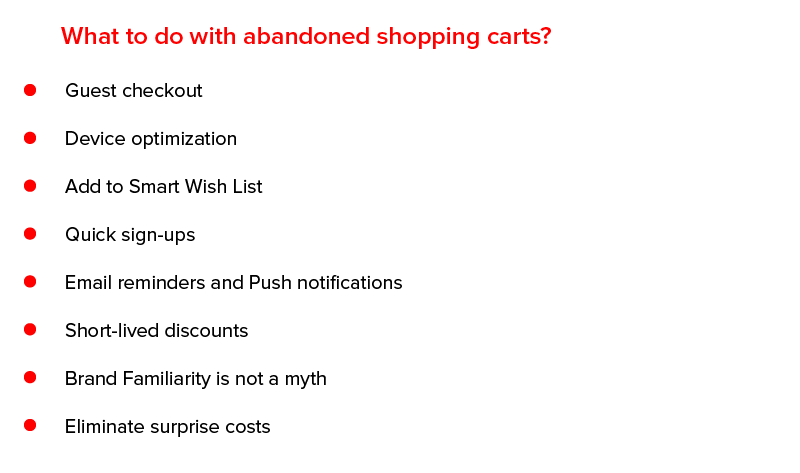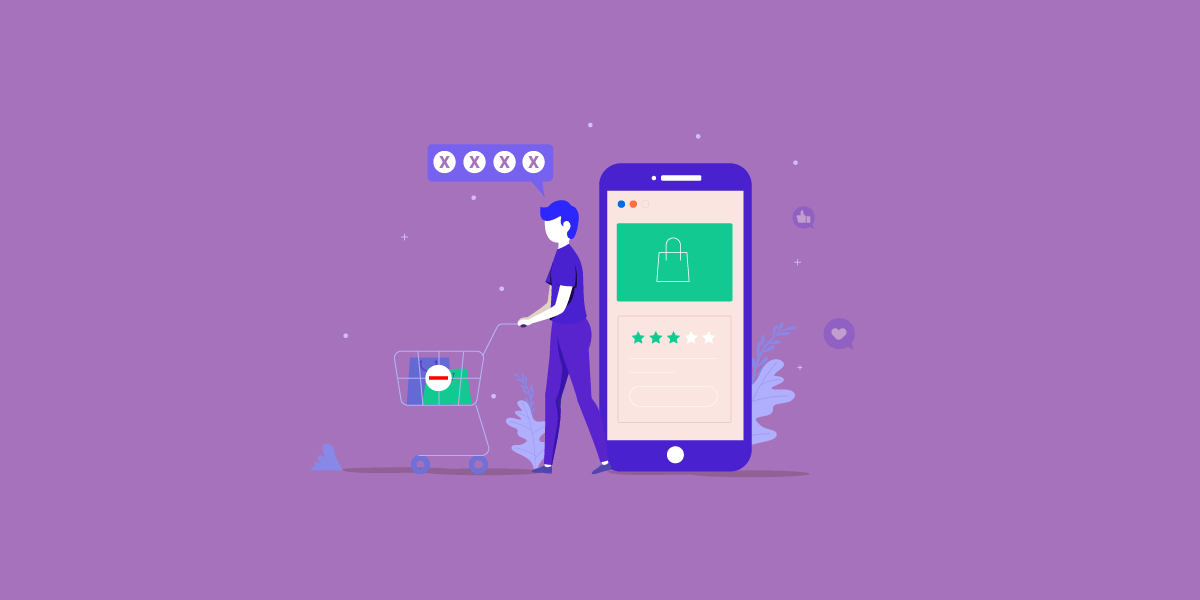How can M-Commerce Apps Lower their Cart Abandonment Rate?
User privacy concerns and lengthy checkout processes often partake the accusation for high shopping cart abandonment rate of m-commerce apps. Whereas, the metrics on users consideration at different stages of virtual shopping, often skips the bare eye. In this read we will narrow down upon- What are the main reasons and how can m-commerce apps lower their cart abandonment rate?
Imagine you are at a shopping store. You pick all the stuff that you intend to buy, place it in your cart when suddenly your phone starts buzzing. It’s a call from your longtime friend. You lose focus from shopping, or rather forget about the shopping bucket altogether before you leave the store.
We all know that is very unlikely to happen in a brick and mortar store.
But for virtual shopping carts on mobile and web, this scenario is recurring, common and obvious.
Even the slightest of interruption from calls, messages, notifications, or environment can make your buyers leave the cart without making an actual purchase.
Marketers must know that there is a reason for every cart abandoned!
What are the major shopping cart abandonment reasons? In an empirical study by Research Gate, we find the following cognitive and behavioral reasons for high shopping cart abandonment rate in 2019:

Fact: MasterCard and University of Oxford came together to hold a study in 2017 that reveals a drop in one-third of purchases is due to users forgetting their passwords. This leads to a common user preference of biometrics over passwords.
Statista Shopping Cart Abandonment Statistics:
Shopping cart abandonment is the pain in the foot of every m-commerce or online retail store today. For vigilant marketers, they bring meaningful learnings about user behavior. You can try and turn your cart abandonment into key insights to restabilize all that is wrong with your marketing plan.
Let us look at the shopping cart abandonment Statistics 2019, to see if there is a silver lining to this problem- A technique for every m-commerce app that needs shopping cart abandonment optimization.

(Source)
So how to fix cart abandonment? One thing that is fairly evident is that a good conversion rate optimization approach can sustain and re-engage your audience to lower your cart abandonment rate.
How to convert abandoned carts? The Conversion rate Optimisation Approach
What if you choose to do nothing about the high cart abandonment rate?
You miss a lot of revenue and fail in conversions as your users continue to jump off the ship. On an average rate of cart abandonment is 68% for ecommerce retailers.
Everyone is looking for a quick fix to develop a customer base that keeps returning for more. The quest to recapture the lost value has become the food for thought, for many bloggers, marketers, entrepreneurs, and agencies.
We all are users at some point in our day.
Think like one! One technique to reduce shopping cart abandonment is to get the knack of your customer’s mind is to step in their shoes and generate your own perspective. What makes you snap back before you enter your cart details?
Make a list of these points just like we did to arrive at the main causes for effective abandonment cart strategy. While we took a generalists approach, you need the one specific to your business needs.
Many think of their mobile apps as currency vending machines, which they are not. Your mobile app is a platform that brings you an opportunity to develop a relationship with your customer, promote loyalty and leave a lasting impression in your heads.

1. Guest Checkout
Save your shoppers from new account fatigue. Allow them to make a purchase without creating and signing in to their user accounts.
Remember all those times when a paywall or overbearing request kept you from accessing the products on an app. Enabling guest checkout will let your customers browse through the products and share their details only when they are ready.
Understand and accept that the user wants to compare, assess and evaluate the value you offer against the purchase. Encourage users to sign up and log in once they ensure that you offer the maximum value.
In fact, the e-commerce market leaders like Amazon, Walmart, and others are already doing it. They all have a one-step checkout implementation option on their mobile apps.
2. Device optimization
With smartphones taking over the internet, another thing you will like to consider is the device your customers are using to access your website. Users spend about 15 hours a week on their smartphone browsing products on different m-commerce applications. Once the users set their eyes on a product about 45% switch to their laptops or tablets to make the purchase.
Make the mobile-responsive design your first priority. This approach is a great value add to your competitive growth. Optimize your website for mobile shoppers.
Come to think of it from a users point of view. A user who comes to your site has already been there through a smartphone.
Mobile shopping cart abandonment rates are high pertaining to casual browsers. Carts abandoned on mobiles are reopened on websites. So if you let them save the products that they like, you can seal the deal. Later they will come to your site with their visa and keyboards.
3. Add to Smart Wish List
We all have a long list of items that we want to purchase. A wish list lets your user bundle all on that list. With emerging technologies, Smart Wish List can make you stand out and nurture your audience.
The basket works and that is why the cart format has stuck. But very few have the Wish List feature.
Taking an example of an m-commerce app that deals in clothes. Suppose a user really likes a scarf but can’t find a matching pullover with it. Wishlist helps your customers to make a bundle of items in their own time.
Another scenario can be that you are out of stock and running low on the inventory of the pullover. The user can simply add it to the wish list. Once the stock is in the inventory the user gets automatically notified.
Wish least can also help manufacturers make pre-launch bookings, like on new gadgets before the price is disclosed. This brings a lot of customer feedback to the retailers and manufacturers to devise combos, offers, and discounts on selective merchandise. These are all part of the Shopping cart page best practices.
Now make the wish list feature smart. Add options to categorize the wish list for birthdays, anniversaries, paydays and others. Allow users to share the wish lists with each other.
A little push can add the right spices and increase sales revenue. Add a ‘buy before’ criteria to the wish list to bring a sense of urgency. Suppose an expiry time of 60 days can bring the shoppers back before their itinerary disappears into the black hole forever.
4. Quick sign-ups
It’s good if you are not forcing user registration. But it does more harm if you do not remind your shoppers to log in before they go. Keeping it simple and subtle, can capture the user’s attention.
‘Sign up with Google’ is a simple yet strong call to action. Users recognize google in a blink. It is secure, familiar and ideal. Give users the perception of choice, with a quick sign up.
This also tells you about when, where and how users prefer to communicate with you. So strive to secure your m-commerce app using best practices of network encryption.
5. Email reminders and Push notifications
Communicate with your customers to re-stimulate their interest. One of the wise old tricks of marketing is direct communication with your user. Workaround a great email reminder campaign. Being too zealous won’t put you at the right foot here, like bombarding the inboxes with a streak of reminders. By rule of thumb, here is a list of what a good reminder email encloses:
- Vibrant images of the product- To remind the buyer
- A strong call to action- To stimulate decision making
- Brief service guarantee or refund policy- To alleviate any concerns
Another alternative you have is of smart push notifications. If you make good offers the ones that bring a sense of cost incentive to the users, you will hit the jackpot.
6. Short-lived discounts
Cutting down prices may critically affect your bottom line. But it’s a good bait to drive in the shoppers waiting on the fence.
A study of the effect on price discounts and bonus packs on online impulse buying speaks of the impact on users. Percentage discounts make the best detours for items bought for pleasure, while combos and bonus packs work best for utilitarian items.
Time-bound discount offers on items with elastic prices can show your intent that you value your customers. And to a customer that is a great feeling.
7. Brand Familiarity is not a myth
Google Trusted Store badge is one heck of a tag that ensures certainty, reliability and trust factor through visual representations.
A name that your buyer has not heard before is bound to add skepticism about your credibility and offerings. Promote your brand to raise familiarity with your audience. Showing up in google search or social media advertisements will not bring you great returns.
8. Eliminate surprise costs
High shipping costs and taxes often switch off the buying intent in customers. Free shipping on orders above a certain value is not a new idea but the one that makes magic happen. Disclose the additional costs early in the buying funnel.
A Forrester study confirms that surprise costs make 44 percent of online shoppers drift away and uninstall the apps.
Make a serious attempt to reduce all potential barriers between you and the wallet of your users. An active, persistent approach to curb the checkout leaks, navigation and performance issues are a few other things to spot.
Ecommerce shopping cart abandonment solutions are easy to implement if you understand their customers. Implementing the Techniques to Reduce Shopping Cart Abandonment as discussed above will soon make the bounce rates wind down and conversions ramp up.

strategies your digital product..



